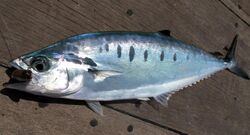Biology:Scomberoides tol
| Needlescaled queenfish | |
|---|---|

| |
| Needlescaled queenfish | |
| Scientific classification | |
| Domain: | Eukaryota |
| Kingdom: | Animalia |
| Phylum: | Chordata |
| Class: | Actinopterygii |
| Order: | Carangiformes |
| Family: | Carangidae |
| Genus: | Scomberoides |
| Species: | S. tol
|
| Binomial name | |
| Scomberoides tol (Cuvier, 1832)
| |
| Synonyms[2] | |
| |
The needlescaled queenfish (Scomberoides tol), also known as the slender queenfish, needleskin queenfish and slender leatherskin,[3] is a tropical game fish in family Carangidae.[2]
Description
Scomberoides tol is bluish-green to bluish-grey on the dorsal part of its body becoming silvery white on the ventral part. It has 5-8 vertically oval black spots along its flanks. The anterior 4-5 overlap the lateral line. The outer half of the lobe of the dorsal fin is a black while the anterior lobe of the anal fin is white. The flank spots are faint or absent in juvenile fishes.[3] The body of this fish is strongly compressed, oblong and elliptical in shape with the dorsal and ventral profiles are similarly convex. In the adults the upper mandible reaches the rear margin of the pupil. The soft rays of posterior dorsal and anal fins are made up of semi-attached finlets.[2] They grow to a maximum recorded length of 60 centimetres (24 in).[1]
Distribution
Scomberoides tol is found in the Indo-West Pacific, its range extending from South Africa northwards to the Persian Gulf. encompassing the Red Sea and Socotra in the east. east into the western pacific as far as Tonga and the Marquesas. In the eastern part of its range it extends north to southern Japan and south as far as the Exmouth Gulf in Western Australia and Queensland in eastern Australia.[1][4]
Habitat and biology
Scomberoides tol is a coastal fish which can be found in estuaries and inshore waters,[3] often forming small schools of adults near the surface.[2] The adults are predators of other fishes while the juveniles have specialised rasping teeth and feed off the scales and skin of other fish.[1] Species in the genus Scomberoides may have venom in the spines of their dorsal and anal fins.[2]
Relationship to humans
Scomberoides tol is a target species for both commercial and recreational fisheries. It is taken using drift set nets, gill nets, seines and hook and line throughout its range. It is mainly sold fresh and it is also used as a bait species in some areas.[3]
The IGFA all tackle world record stands at 1.02 kg (2 lb 4 oz) caught in the Bazaruto Archipelago of Mozambique in 2008.[5]
References
- ↑ 1.0 1.1 1.2 1.3 Smith-Vaniz, W.F.; Williams, I. (2016). "Scomberoides tol". IUCN Red List of Threatened Species 2016: e.T20435185A115382256. doi:10.2305/IUCN.UK.2016-3.RLTS.T20435185A46664124.en. https://www.iucnredlist.org/species/20435185/115382256.{{cite iucn}}: error: |doi= / |page= mismatch (help)
- ↑ 2.0 2.1 2.2 2.3 2.4 Froese, Rainer and Pauly, Daniel, eds. (2019). "Scomberoides tol" in FishBase. August 2019 version.
- ↑ 3.0 3.1 3.2 3.3 Bray, D.J. (2018). "Scomberoides tol". Fishes of Australia. Museums Victoria. http://fishesofaustralia.net.au/home/species/4284. Retrieved 20 November 2019.
- ↑ Eschmeyer, William N.; Fricke, Ron; van der Laan, Richard, eds. "Chorinemus tol". California Academy of Sciences. http://researcharchive.calacademy.org/research/ichthyology/catalog/fishcatget.asp?spid=15437.
- ↑ "Queenfish, needlescaled". IGFA. https://igfa.org/igfa-world-records-search/?search_type=CommonName&search_term_1=Queenfish,%20needlescaled. Retrieved 14 June 2019.
Wikidata ☰ Q1872666 entry
 |



